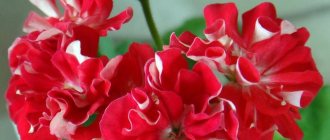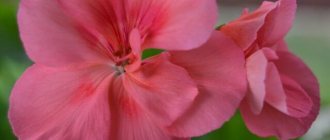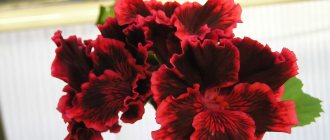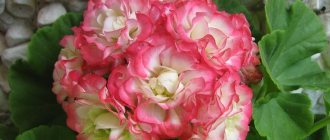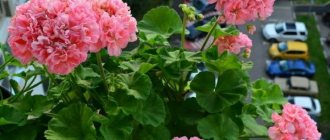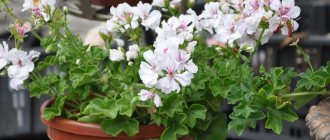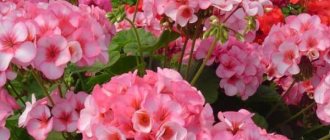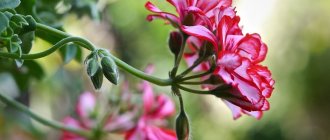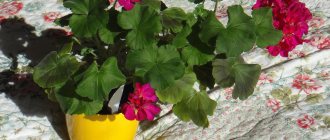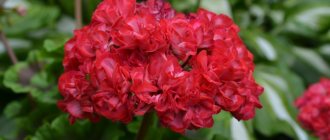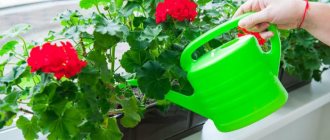The best varieties of terry pelargonium for growing at home
There are many different varieties of terry geraniums, which gardeners are happy to grow in rooms, gardens, flower beds, and summer cottages. In their descriptions, a lot of attention is paid to the color of the petals and the size of the bush.
Pelargonium Pebbles
Pelargonium Pebbles has crimson flowers with a white center. The back of the petals is white. The plant is very small, so it does not require abundant watering. It bushes actively and does not need to be shaped. The lower leaves never dry out. In bright light, a dark green spot appears in the middle of the leaf.
Saxdalens Selma
Pelargonium Mimi
Miniature pelargonium Mimi is distinguished by its pink-fawn petals. It actively blooms and grows; it is not necessary to form it. You can prune the branches a little to make the bush compact. Pelargonium Mimi is ideal for a greenhouse, room, flower bed.
Pelargonium Mallorca
Incredibly beautiful, bright Mallorca pelargonium is characterized by its small height. Its petals are painted in 2 colors: white and pink, sometimes red. Pelargonium Mallorca grows quickly and spreads widely, so its branches need to be periodically pruned.
Note! This variety should not be confused with the Majorca variety, which is topped with pale pink or white flowers. Mallorca is a zonal species, and Mallorca pelargonium is a cactus species.
Silk Moira
Pelargonium Saxdalens Selma
Pink flight flowers on a small bush are a distinctive feature of Selma pelargonium. The back side of the petal is slightly lighter. The flowers form very large and dense inflorescences, so the plant looks like a rose. Selma is a zonal pelargonium. It will decorate any flower bed, garden or room. Due to its external resemblance to a rose, the flower looks luxurious.
Silk Moira
The light apricot shade of the petals is the pride of the Shelk Moira variety. A light green circle is visible in the center of each leaf. A miniature bush with a dense inflorescence looks elegant and resembles a bouquet of roses.
Brookside Fantasy
A very small bush with lilac or soft pink flowers suitable for growing in pots on a windowsill. The leaves have an unusual color: in the center and along the edges they are light green, and in the center there is a ring of a darker shade.
Brookside Fantasy
Bold Carmine
Bright red, crimson, burgundy flowers are a distinctive feature of the Bold Carmine variety. They bloom actively, abundantly, luxuriantly, and bush quickly. This is one of the most profusely flowering varieties.
Geranium Majesta
Majesta is a pelargonium with bright, juicy petals of a reddish-purple color. Lush, dense inflorescences decorate a low bush that branches and grows well.
Ludwigsburger Flair
The light pink and white flowers of Ludwigsburger Flair look charming. There is a green core in the center. The reverse side of the petal is white or very light. The peculiarity of this variety is that it does not tolerate dry air, low temperatures and open solar radiation. It needs a little shade.
Bold Carmine
Lara Harmony
Pink or crimson flowers make Lara Harmony look like rose bushes. The inflorescences are thick and dense, the bush is actively growing. The plant requires careful treatment and good care.
White terry geranium is a favorite of many gardeners. She looks tender, pure, defenseless. This plant blooms from March to November, actively grows and branches. You can choose the following types of white pelargonium:
- Ise Rose;
- Jacky Gauld;
- Joan of Arc;
- PAC Blanche Roche;
- PAC Viva Carolina.
Geranium Himalayan Plenum belongs to the Geranium family, but is also a double flower. Its lush purple petals form large inflorescences on a tall bush. This plant can be grown in the garden or flower bed.
For your information! The name Pelargonium means “stork” in ancient Greek. The plant was named so because the shape of the petals and seed pod resembled the beak of a stork.
Majesta
Varieties with purple and lilac flowers
Despite the large number of varieties, many of them are very rare in floriculture. At home, red or pink geraniums are most often grown. However, purple ones are also popular, but there are an order of magnitude fewer such hybrids. Let's list the main ones, which in my opinion are the most beautiful.
Summer Skies - Don't be surprised that common meadow geranium is included on this list. This variety has double buds with light purple corolla petals. The leaves are pointed with clear veins, which is characteristic of ordinary geranium. This is a garden variety. It is extremely unpretentious to climatic conditions. Therefore, the variety is often grown in gardens. However, the flower is becoming more and more common at home.
Colorado Compact is an incredibly rich dwarf variety. Both the foliage and purple flowers are very bright. Dwarf variety with semi-double buds. The petals are pink-lilac or entirely indigo. Toward the center they turn white or a lighter shade. Therefore, the bud seems voluminous and large.
PAC Blue Sybil - more popular as Fibrix variety. The flowers are semi-double and large. The petals of the corolla are bright in color, slightly crimson. A cap is formed on a small plant with green decorative leaves. The variety belongs to the ivy-leaved variety, but the buds look like small roses. The bush grows compact and independently forms a beautiful, neat bush.
Borthwood Stellar is a variable variety. There are varieties with pink, lilac, red and purple buds. The peculiarity of star pelargoniums is that they have dissected corolla petals. Therefore, the bud is very similar to a carnation. And the thick terry only increases its resemblance to a garden plant.
Lara Gem is a gentle hybrid. The flowers are semi-double, large, slightly untidy in shape. The inflorescences are large, but there are few buds (up to 15 pieces). The variety belongs to the group of IVY hybrids - their “parents” are zonal and ivy-leaved species.
Pelargonium Lady Gertrude - what kind of flower is it, what family does it belong to?
The culture was bred by European breeders. They were faced with the task of making the plant bloom in summer and autumn. At the same time, scientists tried to obtain a new type of pelargonium of small height with unusual flowering. It took them 25 years to do this.
The flower has beautiful pale pink inflorescences
For selection, ivy-leaved and hybrid varieties of geranium were used. As a result, we managed to obtain geranium of the Lady Gertrude variety. It is rarely found on sale, but is often grown by experienced gardeners.
Brief description, history of origin or selection
Pelargonium Lady Gertrude is a hybrid that has many features. The plant has an underground rhizome, on which thick and thin fragments alternate. The culture is characterized by a small number of peduncles, which are gradually covered with large pink petals. As they bloom, they take on the shape of a rose.
Lady Gertrude has large decorative leaves. At the same time, the bush itself is compact in size. It tends to grow in width, but at the same time it is quite dense. Due to this, pelargonium is given any shape.
Additional Information! The key feature of this pelargonium is the late onset of flowering. This variety is considered one of the most attractive. At the same time, it is easy to grow.
A distinctive feature of the variety is the late onset of flowering.
Agricultural technology
Pelargonium Lara Harmony is considered unpretentious in care, but even this variety requires certain simple rules in cultivation. If they are not followed, the plant does not bloom, looks sickly, and later dies.
Soil requirements
Pelargonium Pink Rambler
Prefers slightly acidic or acidic soils. For the base, universal soil is most often purchased: vermiculite, river sand, perlite. Leaf soil from the site, peat (a mandatory mixture with neutral acidity), and turf are added to the soil for abundant fruiting.
Note! The flower grows well in loose and well-drained soil. If geraniums are grown on window sills, then clay or ceramic pots are used as containers. If it is plastic, then only white so that it does not get too hot in the sun and does not rot
If it is plastic, then only white so that it does not get too hot in the sun and does not rot
If geraniums are grown on window sills, then clay or ceramic pots are used as containers. If it is plastic, then only white, so that it does not get too hot in the sun and does not rot.
Pelargonium on the windowsill
Reproduction and planting
Pelargonium Lara Harmony propagates in 2 ways: cuttings and seeds.
The first option is a simple procedure:
Freshly cut cuttings are immediately sent to a container of water so that they form roots
It is important to maintain a high temperature (from 25 degrees Celsius) and change the water every 2-3 days. When the cutting gives good roots, it is removed from the container and allowed to dry for 3 hours to drain off excess moisture. The sprout is planted in soil treated with manganese. As soon as the first signs of growth appear, the top of the plant is pinched off. If the cuttings are planted in open ground, then the seedlings are prepared in March-April, when possible frosts have passed. Planting takes place in mid-April
Planting takes place in mid-April
If the cuttings are planted in open ground, then the seedlings are prepared in March-April, when possible frosts have passed. Planting takes place in mid-April.
Planting geranium cuttings
The second method is labor-intensive and time-consuming.
Most often, it is used by experienced gardeners and breeders who develop new varieties of pelargonium:
- Only loose soil with the addition of humus, sand, and peat is suitable for growing.
- Planting is carried out in March or earlier, subject to good lighting. In winter, the plant is illuminated with ultraviolet light.
- Seeds are slightly buried in the soil without sprinkling soil on top.
Care
Geranium requires space and good lighting, so choose the south side with a small number of seedlings. A crowded arrangement forces you to stretch out.
In summer, the plant requires much more moisture than in winter. In summer, watering is done once every 2-3 days as the soil dries.
Important! Stagnation of water leads to rotting of geraniums. Between waterings, the soil should dry to a depth of 1.8-2 cm. Organic fertilizers should never be used as fertilizer.
It is better to use enriching substances based on nitrogen, phosphorus, and potassium. It is necessary to fertilize the plant 2 times: before flowering and after. Before feeding, pelargonium is fertilized abundantly
Organic fertilizers should never be used as fertilizer. It is better to use enriching substances based on nitrogen, phosphorus, and potassium. It is necessary to fertilize the plant 2 times: before flowering and after. Before feeding, pelargonium is fertilized abundantly.
Feeding pelargonium
To form an even bush of pelargonium on the windowsill, it is recommended to rotate the plant once every 2 days.
When and how to replant
Geraniums are replanted when the root system grows strongly, the flower is flooded, or there is no flowering. It is advisable to carry out the procedure in the fall, when the plant is dormant.
For new soil, drainage is prepared, which occupies 1/5 of the soil. Lara Harmony is taken out so as not to damage the root system. The rotting parts are removed with sharp scissors. The plant is transferred to a pot and watered. Afterwards they put it in a dark place for a week.
Note! Fertilizing is applied 2 months after transplantation.
Methods for propagating a flower, when is it best to do it
The plant can be propagated in different ways. Most often, propagation is carried out by cuttings or seeds. The florist decides which method to choose.
Propagation by cuttings
For cuttings, you need to cut shoots 10 cm in size. They should have 1-2 leaves. The branches should be placed in moist soil. It should consist of sand and peat.
After 2-4 weeks, the seedlings form roots. They need to be watered as the soil dries out.
The plant can be propagated by cuttings
Attention! It is not recommended to place plants in water. This method of rooting will lead to rotting of the root system
Propagation by seeds
It is recommended to plant seeds from December to April. For this purpose, a composition based on sand and peat is used. The planting material should be buried 5 cm. The top of the container should be covered with glass or film.
The temperature should be +22..+24 degrees. After 4 leaves appear, the bushes can be replanted.
Possible problems
Almost all problems that arise when growing Lady Gertrude pelargonium arise from the lack of proper care for it. Next, we will consider the most common health and well-being problems with this plant. We will also tell you how to cope with diseases.
With leaves
If a yellow edging appears on the tips of the plant's leaves, this indicates a nutritional deficiency problem. If such a symptom is detected, be sure to feed the pelargonium with mineral compounds with phosphorus and potassium. If the color of the foliage changes to an uncharacteristic reddish color, this may indicate a lack of magnesium in the soil or that the air temperature is too cool.
Pests
When spider mites appear on pelargonium, the leaves become deformed: swellings, bumps, and dry areas appear on them. If spots of different shades appear on the leaves: yellowish, whitish, beige, this means that the plant has been occupied by aphids. Insecticidal preparations will help to cope with pests.
Diseases
Pelargonium Lady Gertrude, of all the diseases dangerous to these flowers, is more prone to bacterial varieties. Thus, a disease such as black rot often occurs. Pathology manifests itself as blackening of the root, stem, and then leaves.
As a result of this disease, the entire plant dies, and there is no cure for it. Rot can only be prevented by disinfecting the soil before planting and preventing it from becoming waterlogged. Powdery mildew is also dangerous for this pelargonium. The disease manifests itself as a whitish coating on the leaves, and systemic fungicidal preparations will help cope with the scourge.
Slow growth and development
In addition to the above, pelargonium may also experience growth problems. Such defects also have their own reasons - we will consider them further.
Note! Poor, slow flower growth is usually observed when the soil is infected with parasites, as well as when the acidity level of the latter is inappropriate.
If the plant grows very tall but does not bush, the problem is a lack of sunlight. Move the pot to a brighter place. Slow growth along with yellow foliage may indicate a lack of nitrogenous minerals. In this case, feed the pelargonium with appropriate fertilizers.
If the plant stretches too long, this indicates:
- excessive watering;
- excessive feeding;
- no pinching.
About pelargonium Lara Harmony (Lara Harmony): description and characteristics of the variety, care
I haven’t compiled a catalog yet, but I have a list of my plants. Here he is.
Ainsdale Duck Anita rosebud
Brixworth Pearl compact zone Bold Minstrel
Bold Gold goldenfoilCarole MunroeCook's Scarlet and White rosebudDavinia Edwards Tamara
new
Edwards Christina
new
Edwards Blanche
new
Edwards Pleasure
new
Edwards Toscana
new
Edwards Romany Fischers Appleblossom rosebud Godshill stellar[/bHighfield's Charisma Highfield's Sugar Candy
Jägershus Mormor Märta Kenny's Double
Lauren Alexandra Lara Harmony
Lara Delight Lady Mavis Pilkinton Lara Suzanne
zonartik NorrlandOdensjö Suzie Wong
Odensjö Poetry In Motion
Odensjö Sofie Arden PAC Evka miniature ivy
PAC Viva Rosita PAC Viva Madelaine
Pink Vectis Sparkler stellar Powder Puff Rushmoor Golden Ruffles stellarRushmoor Golden Rosebud yellow leaf rosebu Santa Maria Centennial
ivy hybrid
Saxdalens Selma Unicorn Zonartic Rose Alex Kitson Gladys Weller Highfied,s Cameo Highfield,d Ballerina Highfield,s Prima Donna Jacky Gauld Jagershus Rod Rudolf PAC Aristo Petticoat Rio Grande Rose Down
Odensjö Mathilda IV — Sonya Nezhnaya Thornland's Marble Wood's SurpriseBold Beacon
More new items are expected! I'm looking forward to.
Unfortunately, certain family problems over the last 2 weeks have left virtually no time for flowers. I barely have time to water, and then late. Not everything that was supposed to be trimmed was trimmed. But I’ll definitely catch up! And the flowers sense the approach of spring perfectly. Uncut horses, miniatures and autumn cuttings are especially happy. Blooming! And even decently.
I'll show you a few photos of today's flowering. When there is still time.
Dwarf Ingrid/Crycksbo
. Tireless bloom. I have two plants, one stands in the south, the second winters in the north without lighting. Both are doing great, but the one in the north is not blooming yet.
Just Jip
. A beloved variety. One of those that feels great under the lamps. It grows and blooms well under them. It grows so well that it does not require pruning. I definitely won’t cut my plant, I’ll just transplant it into fresh soil. And such a hat. not small. Handsome!
Post edited by lenaxi
— Sep 18 2022, 22:24
https://7ogorod.ru/cvety/pelargonia-lara-harmony.htmlhttps://greensotka.ru/tsvetushchie/geran-makhrovaya.htmlhttps://forum.na-svyazi.ru/?showtopic=1456412&st=765
Varietal diversity
Pelargonium has several hundred different varieties. Let's take a closer look at the Edwards series. It belongs to the zonal group due to the special color of the leaf. During flowering, the color of the leaf blade changes, dividing it conditionally into two zones.
Lighter in the center, the color becomes darker and more saturated towards the edge of the leaf. All zonal varieties of pelargonium are divided into non-double, with 5 petals, semi-double, with 6 to 8 petals, and double, with 8 petals or more. Depending on the size of the bush, plants are divided into ordinary (standard) and dwarf. The standard can grow to a height of 30-50 cm, and the dwarf is usually no higher than 25-30 cm. Consider the most popular specimens from the Edwards series.
Calico. The flowers are large, double, and have a delicate silver-lilac hue, quite unusual for pelargoniums. The bush is dwarf, but very branched.
Pelargonium zonal: the best varieties with descriptions
For almost a century, breeders all over the world have been breeding new varieties of pelargonium. Thanks to their efforts, an incredibly large number of different varieties and varieties of this ornamental plant were obtained. The culture is not overly demanding in terms of growing conditions and, with proper care, will definitely respond with lush, luxurious flowering. We bring to your attention detailed information about zonal pelargonium, as well as its best varieties (photos with names and descriptions are attached).
About zonal pelargonium
This is one of the most common groups of plants, represented by a large number of species and varieties. Varieties belonging to the group of the same name are considered zonal because they have a certain zone on the leaves, colored in a different color (most often in the form of a small ring-shaped or rounded spot). Pelargonium zonalis is perfect for growing not only indoors, but also in open areas.
The variety is represented by an erect, fairly branched and powerful bush, densely covered with foliage. The bush is covered with small lush umbrella flowers. The leaves are heavily pubescent and have a specific odor. Zonal pelargoniums are also divided into several varieties depending on the number of petals on the flowers. So, they come with 5-8 petals (sometimes more).
Pelargonium is an unpretentious plant
Zonal pelargonium is a rather unpretentious plant in terms of growing conditions, but quite demanding in terms of care. It is necessary to provide it with the necessary amount of solar heat and light, nutritious and regular feeding, saturate it with moisture, etc.
Advice. In winter, it is necessary to provide the plant with sufficient access to cool air. If this is not possible, remove as many bare shoots from the plant as possible in the spring.
Basic classification of zonal pelargonium
Zonal pelargoniums, in turn, can be divided into several subgroups:
- Rosaceae. All varieties presented in this category have luxurious double flowers that look very reminiscent of classic roses.
- Tulip-shaped. The flowers of varieties from this group are small flowers collected in inflorescences. Outwardly they resemble small unopened tulip-shaped buds. The petals of tulip-shaped pelargoniums have a rather unusual appearance: they are slightly inclined inward and lowered, as if they have already begun to fade. This in no way means that the plants are actually withering. In fact, the sluggish appearance of the petals is a specific feature of the variety.
Tulip pelargonium
- Star-shaped. Star pelargoniums are completely different from their “compatriots”: the flowers of these dwarf plants have an unusual shape of a pointed star. Moreover, quite often the two largest petals have an elongated shape with a sharp end, which makes them different from the rest.
- Dianthus. The varieties presented in this category are very similar in appearance to garden carnations: they are just as large, with carved petals of a fairly bright shade.
Carnation pelargonium
- Cactus-like. A rather rare variety of zonal pelargonium, which is represented by a fairly large, heavily leafy bush. The leaves are wide, bright green. Flowers of cactus-shaped varieties look quite unusual: their petals seem to be rolled into narrow tubes. Quite often they have a slightly “disheveled” appearance.
- Deacons. Quite young hybrids that appeared on the world flower market less than 50 years ago. They are presented as a very compact, abundantly flowering bush with a small rosette of flowers in a soft peach, pink or red hue.
Let's take a closer look at several of the best representatives in each category of zonal varieties of pelargonium. Among the most popular rose-colored varieties are several:
- April Snow is a neat dwarf plant with small double pink flowers in the form of roses.
- Denise is a powerful plant that every year is covered with a large terry cap of pink or peach color.
- Monseruds Rosen is not easy to grow - it is quite difficult to form the required shape, it is distinguished by luxurious burgundy flowering.
Among the most popular star varieties of pelargonium are the following:
- Aunty Pam – Stellar. The variety is represented by a fairly compact, well-branched bush, densely covered with luxurious bright pink flower rosettes. Externally, the flower petals resemble a small terry carnation.
- Borthwood – Stellar. Another excellent star variety, this is a heavily flowering dwarf shrub whose leaves are shaped slightly like frogs' legs.
- Fandango. A rather unusual variety, the flowers of which look slightly “shabby”: the shape of the petals is a little torn, with fuzzy edges. The plants bloom abundantly and lushly; the flowers have a pleasant soft coral hue.
Among the cactus-like varieties of pelargonium, the following can be noted:
- Fascination (the petals of the plant are quite long, with edges bent down, which makes their appearance very extravagant, somewhat reminiscent of human nails);
- Noel (the petals of the plant’s flowers have a delicate white color and a twisted shape, with a pinkish anther rising in the center).
Advice.
In order to grow luxurious, lushly blooming pelargonium in your home, you need to periodically trim its branches (it is advisable to carry out this procedure in the autumn). This will speed up the growth of the plant and improve its appearance. This concludes our acquaintance with one of the varieties of such an unusual and pleasant plant to grow as zonal pelargonium. Good luck!
Pelargonium varieties: video
dachadizain.ru
Varieties of indoor plants with names and what they look like
The constant work of breeders allows us to select the most suitable type of pelargonium for certain conditions. The main differences between flowers are in size, shape of inflorescences and color of petals.
Yu-Jiga
It is a standard subspecies with a straight stem and medium dimensions. Coral inflorescences are double type, quite dense. Pelargonium Yu Jig delights every lover of house plants with its beauty.
Lake
It is unpretentious, the inflorescences have a spherical shape, salmon-colored buds, the petals of which become lighter closer to the edge. Rounded foliage with a brownish edge, the bush grows to medium size.
Rafaella F1
It is characterized by a compact appearance and a height of up to 30 cm. Suitable for keeping in rooms, loggias and flower beds. Terry buds come in milky, orange, peach, and scarlet tones. The variety was recently bred and is rarely found on the market. Easily tolerates cold and hot conditions.
Note! If the plant is properly cared for, buds will form all year round.
Pelargonium Raphaella F1
Bold Gold
It is grown outdoors and indoors. Characterized by abundant flowering. The foliage is light green in color with a ring of brownish tint located in the center. The buds are pink and red.
Minx and others
Pelargonium Lara Harmoni has double flowers with a lilac tint; its large umbrella-type inflorescences appear from the beginning of spring and fade by the end of autumn. It is distinguished by its miniature size. Pelargonium Lara Harmony has buds that resemble roses.
Minx is characterized by its small size and bright scarlet petals. Combined with dark foliage, they stand out greatly. Each variety has its own characteristics; experienced flower growers collect entire collections that differ in the growth and color of the inflorescences. Pelargonium Silk Swan is interesting for its massive stem, covered with dense leaf plates and snow-white buds.
Important! Sellers in flower shops do not always understand the culture. When purchasing, it is better to focus on Latin names
Among the indoor plants you can find:
- Pelargonium Lara Delight with medium size, fuchsia-colored inflorescences and a white core. In addition to its splendor, it is distinguished by the unusual tone of its petals. Pelargonium Lara Delight appeals to gardeners who love bright and rich colors. Plants with larger sizes or calmer bud tones are selected for the garden.
- Pelargonium Yu Disko can be found in rare cases; it is not one of the popular ones. The petals are painted in soft pinkish tones, the buds are collected in umbrella inflorescences. The spherical flowers are located on high peduncles and stand out among other crops.
- Pelargonium Yu Princess - characterized by rose-like inflorescences with a light pink tint. After some time, its petals curl into tubes, giving it an unusual appearance.
- Pelargonium Yu Kathak has an unusual color of leaf blades: the overall yellow background is emphasized by a brownish border. Inflorescences are double type, with a bright red tone. A large bush easily survives pruning.
Important! Flower shops sell plants of various subspecies (Yu Gamayun pelargonium, Yu Lilac Mist, Yu Sirin), but workers usually do not separate them. As a result, the buyer purchases a mix of geraniums of different shades
Pelargonium Minx
Terry geranium - what kind of pelargonium is it?
Terry geranium (pelargonium) belongs to the Geraniaceae family. About 500 species of this plant are known. Today, breeders have bred geraniums in almost all colors of the rainbow and all kinds of shades.
Pebbles variety
This flower is native to South Africa. It was first bred in 1631 by an English botanist and was initially called geranium. Much later, in 1789, the current name appeared.
Terry geranium is a zonal variety of pelargonium. Large spherical inflorescences, resembling roses in appearance, are located on the upper branches of the plant. This species appeared in the middle of the 19th century.
For your information! Pelargonium terry is not related to the genus Geranium.
Variety Mimi
Features of the flower
Terry geranium with roses contains several corollas, each of which contains more than 8 petals. On a tall, thick, strong stem there are round leaves with wavy edges. In many geraniums, the edges of green leaves are framed by a thin rim of burgundy or purple. There are rare varieties with black, golden, bronze and purple leaves.
The diversity of species and varieties of Geraniaceae Pelargonium depends on changes in its genome. Sometimes this happens spontaneously. If a flower of a certain variety turns out to be different from the sample, then in such cases they say that pelargonium has acquired a sport. The shape and color of petals, leaves, stem size, density of inflorescences and much more change.
Note! Pelargonium purifies the air, drives away pests from neighboring plants, repels mosquitoes
Variety Mallorca
Catalog of geraniums (pelargoniums) with photos and descriptions of different groups, agricultural technology and varieties
The geranium catalog allows you to choose suitable species and varieties for growing at home. These amazing plants allow you to create a real garden in your apartment with minimal effort. You can get acquainted with a detailed description of different species groups in the materials presented in this section. The agricultural technology of the crop is quite simple and does not require any special knowledge and skills. Typically, geranium takes root well and blooms beautifully even under unfavorable conditions. The pelargonium catalog allows you to choose zonal and bordered, royal and meadow, ampelous and dwarf forms of these plants. Look at the catalog of geraniums with photos illustrating the availability of a variety of bud colors. But the terry species of pelargonium presented in the catalog with photos and descriptions will not leave any gardener indifferent.
Geraniums (pelargoniums), presented in the catalog accompanied by numerous photos, have beneficial and healing properties. Read about which ones exactly in the special materials in this section.
20 Nov
A very rare indoor flower, rosebud pelargonium, is a very large group of the Zonal species. The rosacea geranium plant is a very exquisite and beautiful crop. The bushes, varied in growth, are famous for their very lush double flowers, located in umbrella inflorescences at the tops of herbaceous shoots. Young well-groomed plants resemble bouquets of miniature roses. The buds of zonal rosebud pelargonium (Rosebud Pelargonium) due to the large cluster […]
18 Nov
Tulip pelargonium or geranium is a large group of the Zonal species of the plant genus. In home floriculture, the variety is extremely rare. She is more whimsical and gentle, unlike other representatives of the group. Tulipa pelargoniums (Tulipa Pelargonium) were bred at the Andrea family nursery in the USA. Breeder brothers tried for a long time to develop new hybrid varieties of geraniums and having received the first variety with red […]
15 Nov
Like any other beautiful houseplant, ivy-leaved pelargonium deserves special attention, since its prevalence rightfully overshadows the popularity of all other crops for interior decoration. A very beautiful outdoor and indoor plant is ivy-leaved pelargonium (Pelargonium peltatum); it was not forgotten for a minute by breeders and flower growers after its discovery. Neat long shoots hang and form [...]
14 Nov
Pelargonium Zonale or Zonal Pelargonium is an exotic flower that was brought from South Africa to Europe. In the 17th century, the culture was introduced by pioneers and quickly spread among European flower growers, unspoiled by African exoticism. Initially, the plant was considered a sign of family status, since only high-ranking people in society could afford it. Over time, Pelargonium, due to easy hybridization, quickly […]
06 Nov
Wild or forest meadow geranium (Geránium praténse) is found in the climatic zone of central Russia. The plant belongs to the medicinal herbs and is included in the Pharmacopoeia of the Russian Federation. The main medicinal properties and contraindications for use are described in this article. The meadow geranium variety (also known as crane grass) is a very common wild plant. It is found in the European part of Russia, Western [...]
06 Nov
White geranium grows wild in warm regions with mild winters. In the Russian Federation, it grows in gardens only in the Krasnodar and Stavropol Territories. Growing white geranium at home is simple and accessible to novice gardeners. Geranium or Pelargonium is considered a popular indoor plant by botanists. Some gardeners manage to grow in open ground. Decoration for the front yard or garden [...]
20 Oct
Terry pelargonium is a large group of plants. These representatives include specimens with large or small flowers, which have 8 or more petals of various shades in the corolla. Many gardeners are mistaken in thinking that this is a group of exclusively zonal subspecies. In fact, there are varieties of other varieties with densely double rosettes. Terry geranium with roses [...]
19 Oct
Pelargonium angel is a group of geraniums that have a certain set of genetic qualities. Proper care of them at home guarantees lush and long-lasting flowering. It also has another name - the spectacular Viola geranium, distinguished by its magnificent color and shape of the petals. The Angel pelargoniums group are not dwarf royal geraniums, as some gardeners mistakenly believe. This opinion arises because [...]
15 Oct
Fragrant geranium is an indoor plant that has enormous medicinal and healing potential. Allows you to effectively disinfect a room within a few minutes of being in it. In this material, we will look at fragrant pelargonium (Pelargonium graveolens) and understand the questions of how to propagate it at home using apical cuttings. It also provides comprehensive information on how [...]
15 Oct
Ampelous pelargoniums or geraniums are special varietal groups used to effectively decorate gardens and rooms, balconies and terraces, verandas and gazebos. The group of ampelous Pelargoniums includes only one variety popular in floriculture - Ivy or Thyroid Geranium. She and her varieties occupy special places in private collections. Many varietal groups of plants are very whimsical and require [...]
floribus.ru
How to care for pelargonium at home after purchase
Geranium is a very heat-loving perennial plant that does not tolerate temperatures dropping to 0 °C. It needs room temperature, good lighting, and regular watering. The plant requires simple care and good conditions. It can be grown both in pots and in open ground.
If the lighting is not enough, you need to illuminate the pelargonium with a lamp. It is worth watering with filtered or infused slightly warm water. In spring and summer, geraniums are watered once every three days, and in autumn and winter - once every 10 days or 2 weeks. Water should not stagnate in the pan. You cannot spray geranium. The plant needs to be trimmed 1-2 times a year as it grows.
Is a transplant necessary?
Pelargonium needs to be replanted when its roots grow and the pot becomes too small for it. It can be replanted in early spring: from late February to April. Initially, this plant needs to be planted in a small pot.
How to determine if it's time to replant geraniums:
- the flower grows too slowly;
- the soil dries out quickly;
- roots are coming out of the pot.
To replant a geranium, you need to remove it from the pot along with the root and soil and place everything in a new pot with ready-made soil. After planting, the flower is watered, then placed in a bright place where there are no drafts.
What should the soil be like?
Terry geranium loves light soil types that can conduct air. The acidity level (pH) should be 5.5–6.5. You can prepare soil from several components:
The soil is also suitable for succulents. Experienced flower growers say that it is better to prepare the soil yourself, but this takes time. All components must rest for a year, then they must be sterilized, dried, sifted
It is very important to mix the soil components in the required proportions. Good drainage is also needed. Important! Purchased soils have a sufficient degree of fertility suitable for geraniums
In stores you can find special mixtures for pelargoniums.
Important! Purchased soils have a sufficient degree of fertility suitable for geraniums. In stores you can find special mixtures for pelargoniums.
White terry geranium
Subtleties of landing
There are two methods of planting pelargonium: cuttings and seeds. At the same time, the simplest and fastest of them is cuttings. If you care for the cuttings correctly, you can quickly get a beautiful bush from it.
It is easier to plant pelargonium from cuttings
Planting cuttings and caring for them
It is recommended to wait until spring to prepare cuttings. The whole process is like this:
- cut a 5-7 cm shoot from the lateral or apical shoots of adult pelargonium;
- remove all sheets from it except the top two or three;
- leave the cutting in the air for several hours so that it dries.
In the meantime, treat the sections of the adult flower with a fungicide or, alternatively, sprinkle charcoal; Fungicides - select a small container for planting (a plastic cup is a good option), make small holes at the bottom for drainage, and fill with fresh soil;
- disinfect the soil with a special solution: one or two drops of 0.1% potassium permanganate solution per 100 ml of water;
- when the cutting dries, plant it in a prepared container with disinfected soil;
It is worth disinfecting the soil before planting using potassium permanganate - place the container with the planted cuttings where light will fall on the sprout. However, the plant should not be exposed to direct sunlight;
- Water a little at a time when the need arises. In this case, water should not be poured onto the soil, but into the pan. This is done to allow water to seep through the drainage holes;
- make sure that the plant does not stand in a place that is too cold for it (at a temperature below 15 degrees).
Pelargonium should not be in a place that is too cold
Rooting usually occurs 20-30 days after planting.
How to transplant growing pelargonium into a pot and care for it?
The algorithm is as follows.
Sequence Description
Step 1 Choose a clay pot
Its diameter should not exceed 10 cm.
Step 2 Carefully, so as not to damage the roots, remove the sprout with a small lump of earth.
Step 3 Water from a watering can with a narrow spout.
Step 4 In cloudy weather, use artificial lighting. It is better to plant pelargonium in a clay pot
It is better to plant pelargonium in a clay pot
How to grow?
Pelargonium, like geranium, can be propagated at home in two different ways. Moreover, each has its own nuances.
Cuttings
The main advantage of this method is that it preserves all the unique properties and characteristics of the selected plant variety. The procurement of the material itself is carried out only from spring to early autumn. During the hibernation period of pelargonium, it is not recommended to collect cuttings.
For planting, it is best to choose stems with 3 true leaves, the length of which does not exceed 7 cm. After cutting from the bush, they are left in the fresh air to wilt easily for 2-3 hours. Before planting in a pot, the cut site is lightly treated with a special agent designed to stimulate the formation of the plant’s root system. As soil it is necessary to use only a special substrate intended for the Geraniaceae family.
The cuttings are placed in the center of the container so that there is at least 5 cm of soil under them; the container is also covered with substrate from top to the edges and watered. Place the seedlings in a well-lit place with a temperature of about 22 degrees above zero and leave for 15 days. If necessary, irrigate the seedlings, but water them at the root, without touching the leaves. After about a month, the flower will take root, and after another couple of weeks it should be planted in a larger container.
Sowing seeds
This cultivation of pelargonium at home is carried out from January to the end of February. If desired and special phytolamps are available, the procedure can be carried out in December. You can use peat tablets for planting. The advantage of this method is that there is no need for further picking of plants. The sequence of actions will be as follows.
- The tablets are soaked in warm water for 10-15 minutes.
- Place them on pallets close to each other.
- One seed is placed in each tablet. Sprinkle lightly with water on top.
- Crops are placed in a warm and well-lit place.
Seeds are laid out on the surface of the substrate and sprinkled with soil no more than 2 cm thick. The surface of the crops is irrigated with water. Place in a well-lit place without direct sunlight until seedlings emerge. Regularly monitor the humidity of the substrate - when its top layer dries, the seedlings are watered to the root. The temperature should be from 20 to 23 degrees above zero. Pelargonium picking is carried out when 2 true leaves appear. And when there are 5 of them, the flower is transplanted to a permanent place.
Features of reproduction
The most common method of propagating pelargonium is cuttings, and we will consider it. If you decide to cut a cutting from the mother plant, then it is better not to let it bloom for a year, this is the only way the planting material will be strong and healthy. If everything is done correctly, then this same summer the young plants will delight you with their flowering.
The algorithm of actions is as follows:
- Shoots for propagation are cut in March, using a sharp, sterile instrument. The cut is made at an angle of 45 degrees. You need to leave 2-3 internodes on the cuttings.
- The cuttings are dried in air for 10 hours.
- Remove leaves from the bottom of the prepared cuttings, otherwise they may rot in the ground.
- The cuttings are immediately placed in soil, which consists of sand, soil, perlite and vermiculite. Before planting, the substrate is moistened.
- Cover the cuttings with a glass jar, and do not forget to ventilate every day.
- The roots of the shoot will appear in about a week and a half. Immediately after this, the jar is removed, and the young plant is fed with a mineral complex.
Pelargonium is a beautiful and fragrant plant that is suitable for indoor and outdoor cultivation. You can view our materials about other varieties Bold, Clara Sun, Grandiflora, Richard Hudson, Zonartik, Prince Gustav, Mildfield Rose, Patricia Andrea, Salmon, Lady Gertrude on our website.
Pelargonium Norland is a flower that is loved in many countries. The decorative qualities of the plant and ease of care make it possible to grow this beautiful flower everywhere.
Description of varieties
Lara Harmony
Pelargonium Lara Harmony is one of the varieties that belongs to the zonal group (the name “zonal” comes from the pronounced brown zone on the green leaf of pelargonium).
The flowers are double, lush, and when fully opened their rich pink color resembles a rose.
Lara Delight
This is a beautiful hybrid variety called Zonartik. A very powerful bush, with large, not very double flowers of bright cyclamen color or shades of fuchsia with a small bright white core. Also belongs to the group of zonal ones.
Lara Marjorie
It is a zonartik with a compact lush holly bush. The flowers are large, double, white-yellow, with pink splashes on the upper petals. A distinctive feature is a very long powerful peduncle that reaches 30 cm.
Lara Alf
Pelargonium zonartik with bright scarlet inflorescences and a pronounced core. Blooms very easily. The flowers are large, quite dense, held on a slender but strong peduncle. The bush is compact, low.
Lara Rita
Lara Rita is a flower of moderation in everything. This is one of the hybrids with a low bush. On relatively short peduncles there are dense inflorescences. The flowers are a delicate salmon color, may be brighter, with semi-double petals of medium density.
Lara Largo
The plant has a fairly powerful and dense inflorescence. This pelargonium is distinguished by a vertically elongated bush with very large pink-orange double flowers. The leaves are glossy, almost without velvet, rich green, large and juicy, without a pronounced zone. The stems are dense and smooth.
Lara Enwoy
This variety is not very common. The bush is compact and does not stretch upward. Thick stems grow almost horizontally. The flowers are large, double, white-salmon in color, the petals resemble feathers.
Lara Gem
Lara Gem is a strong, beautiful plant that requires fresh air and space. Medium-sized pelargonium with a high peduncle, with a beautiful lush inflorescence. The flowers are double, pink, with a light spot on the upper petals, the leaves are bright green and succulent.
Lara Genie
Medium sized plant bush. On a tall, strong peduncle there is a delicate umbrella of pale pink color, similar to an orchid flower. The leaves are lacy and bright.
Lara Susanne
A very passionate and expressive flower in appearance. This plant can be easily recognized by the pronounced contrast of bright warm pink shades and rich dark green leaves. It blooms magnificently and abundantly, while being quite unpretentious.
Lara Mandarin
The inflorescence of this hybrid, when fully opened, resembles a round, juicy tangerine. The bright and at the same time delicate peach color smoothly flows into the yellow core. The inflorescence is dense and lasts a long time on a high stalk. The serrated leaves have a lush green color.
Lara Prince
The plant is quite compact, with dark green leaves and a pronounced brown zone. But on this seemingly small bush, relatively large and generous inflorescences bloom. The color of the petals ranges from pale lilac to lilac-pink shades.
There are many other varieties of Lara Pelargonium that are not covered in this article, such as Unicorn Zonartic Rose, Rachel, Orion, Brookside Fiesta, Peter, East Sussex, Lucy Gunnet, Alex Kidson, Bold Limelight and many others. They are all beautiful, and each variety is unusual in its own way.
It's no surprise that many gardeners are in love with these indoor flowers.
See below for fragrant pelargonium Lara Jester.
Varieties of pelargonium with photos of the rosaceous species, video
Pelargoniums with double flowers, reminiscent of garden roses in shape and structure, have enjoyed a long-standing and unabated interest among gardeners. At the same time, there are rosaceous varieties among both zonal pelargoniums and ivy-leaved ones. Hybrids of these two varieties are very decorative and interesting, forming lush, spectacular inflorescences from miniature roses.
Pelargonium Monseruds Rosen
The miniature zonal pelargonium Monseruds Rosen attracts attention not only with the shape of the flowers, which in a half-opened state are very similar to solemn burgundy roses, but also with its unusual colors. The deep pink or burgundy petals are decorated with white strokes, which become noticeable when the flowers are fully open.
The photo of the pelargonium variety is not very clear, but many gardeners note that the plants are difficult to shape and have difficulty producing side shoots. In addition, the variety has a second name: Monsrudblommen, found in Scandinavian sources.
Pelargonium Rosebud Supreme
The rosaceous pelargonium Rosebud Supreme typically enters the flowering season later than similar varieties. Then the plants are rehabilitated and present the grower with a mass of luxurious inflorescences, indistinguishable from bouquets of tiny roses of a beautiful red hue.
The underside of the petals of densely double flowers is light, the bushes are large, powerful, unpretentious in care and can please any lover of indoor flowers.
Pelargonium Vectis Rosebud
A very small bush of pelargonium Vectis Rosebud can bring incredible pleasure to both beginning gardeners and connoisseurs of this culture.
The compact bushes of the variety are easy to form, and the flowering is lush and long-lasting. Starting in spring, plants form large inflorescences consisting of rich red rosettes. On the outside, the petals are much lighter than on the front; they do not fade for a long time and do not lose their unique shape.
Pelargonium Lara Harmony
Pelargonium Lara Harmony is one of the most popular abundantly flowering plants today. It is easy to care for, so it often becomes a favorite and is grown on windowsills, flower beds, and small areas.
Lara Harmony belongs to the Terry Pelargonium (Geranium) variety. Belongs to the Geranaceae family, group - zonal. The species was formed due to small areas on each leaf - usually dark brown in color.
Interesting. The flowers of the variety, when fully opened, are incredibly similar to small roses, while the plant is less whimsical and tolerates various weather conditions well.
Growing pelargonium Lady Gertrude, how to properly care for it
In order for the culture to develop normally and delight with lush flowering for as long as possible, you need to carefully study lady Gertrude pelargonium description of the variety and ensure optimal conditions.
Illumination and temperature conditions
It is not recommended to place a flower pot in direct sunlight, as this may cause the crop to burn. It is best to place it on the east window. If necessary, you can use phytolamps.
Important! The plant should receive the main part of the light in the first half of the day. With too much sun, the plant becomes weak and stunted in growth.
After lunch, the pot is moved to partial shade.
Pelargonium can develop on a western window. The duration of daylight should not be longer than 8 hours. In summer, it is worth keeping the temperature at +25 ℃. For winter, +15 ℃ is suitable. In this case, the temperature should not fall below +10 ℃. Geranium cannot withstand extreme heat. An increase in temperature parameters to +30 ℃ can cause the death of the crop.
Watering rules and humidity
The culture needs moderate humidity. The substrate should not dry out. It is recommended not to over-moisten the soil in the pot, as this can lead to rotting of the root system.
The plant should be watered as the top layer of soil dries. In spring and summer, the bush is watered more often and abundantly. In winter and autumn, the amount of moisture is reduced.
There is no need to spray pelargonium; it can accumulate moisture on its own. Drops that fall on foliage and flowers can cause unattractive stains and even cause rot.
Important! For irrigation, soft and settled water is recommended. The liquid should be at room temperature
Fertilizing and soil quality
During the growing season, the plant needs the use of mineral products. During flowering, compositions based on potassium and phosphorus are used. However, nitrogen substances are contraindicated because they negatively affect the formation of buds.
In summer, it is recommended to apply fertilizer once every 2 weeks. In winter, it is not necessary to feed Lady Gertrude pelargonium.
The plant does not require the addition of organic products. Flower growers advise using only mineral preparations. In rare cases, chicken droppings are acceptable.
For abundant flowering, the crop must be properly fertilized.
Flower container size
Small containers are chosen for the plant. The pot should be 1-1.5 cm larger than the size of the earthen ball. Otherwise, the bush will actively grow roots, which will create difficulties with flowering.
Features of plant flowering
Anita is a variety of pelargonium characterized by lush flowering. With proper care it can last quite a long time. During the season, several inflorescences appear on one flower, which both replace each other and bloom simultaneously.
Pelargonium Anita
Period of activity and rest
The period of activity begins with the onset of spring, when the formation of buds begins. The flowering season is long, several months. Most often, Anita pelargonium blooms throughout the summer months until mid-autumn, when the temperature drops and daylight hours are noticeably reduced. The variety requires mandatory rest at low temperatures, reduced watering and no fertilizers. During the winter months, Anita needs to be provided with all these conditions. If she does not rest and accumulate strength for the new season, flowering may not occur.
Types and shape of flowers
The shape of the flowers is round, the inner petals are always tightly closed, so the middle is always closed. The color is very delicate, thin, pinkish. Externally, the flowers of this pelargonium are very reminiscent of rose flowers.
